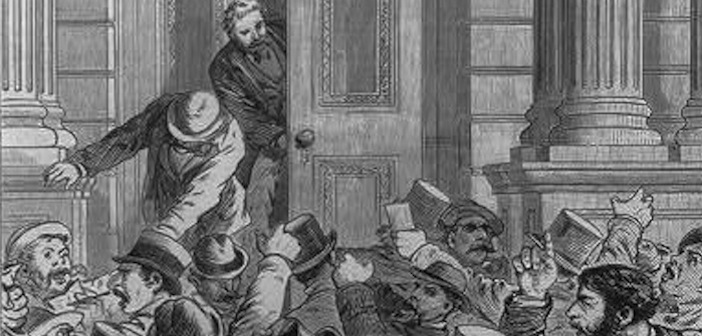Many Americans remember the Great Depression that left our country in financial ruin during the 1930’s.1 However, many of them are oblivious to the depression that was brought on by the Panic of 1873. Even fewer people are aware of the fact that the Panic of 1873 was dubbed the Great Depression until subsequent years when that title was won over by the decade encompassing the 1930’s.2 The 1930’s Great Depression, as we know it today, was brought on by a crash in the stock market (and various other factors, but mainly the events leading up to Black Tuesday, October 29, 1929).3 The Panic of 1873 had various causes that historians still debate for being the most responsible for the economic slump.

Unlike the Great Depression, the Panic of 1873 was brought on by high risk investments into the railroad building business. The demise of Jay Cooke & Company, the leading investor at the time, started a domino effect that was felt not only in the United States but also in Britain (triggering a severe two-decade long slump).4 The firm led financial efforts during the Civil War, and as a result of that, it became an agent for the federal government. Its promise was to build the second transcontinental railroad. By September 18, 1873, Cooke’s investment firm had declared bankruptcy.
The railroad building business was very risky; investors were essentially pouring their money into building industrial tracks leading to nowhere in hopes that the location would become prime locations for commerce. The leading firm, Jay Cooke & Company, decided to fold; a significant number of companies followed, approximately eighty-nine out of the existing three hundred sixty-four railroad companies.5 The majority of these companies declared bankruptcy within the first two years after Jay Cooke & Company declared bankruptcy, meaning that after having invested most of their monies into the railroad building business, most of those companies would rather take the loss than further invest any more money.6 This in turn caused more problems for the average citizen, because of the economic slump that would ensue.

Because industrialization was so vital for the early development of the United States, it is of no surprise that the railroad business was affected the most by that industrialization. The nation’s development was heavily rooted in the industrious railroad market of the time. Strikes, wage cuts, poor working conditions, less hours, and discrimination plagued the few in the working force. Panic had set in. Men were no longer able to provide for their families as they once did because of the decrease in pay and hours.7 This set up a perfect recipe for employers to take advantage; now they could demand more work for less pay because the unemployment rate was so high (peaking at 14%), so anybody looking for a job would have to take what they could.8 This employment competition led to poorer working conditions and even more discrimination, because any working class citizen would do whatever it took to survive during this time period.

The Panic of 1873 had some disastrous consequences. Aside from the corrupt politics of the time (for example, the Grant Administration Scandals), and the economic tatters the country was left in, the country’s values began to disintegrate as well. One of the most commonly known events, the Haymarket Affair, left seven people dead by a dynamite bomb during a labor demonstration, and many others were severely wounded.9 It seemed like the country would never recover; troops were deployed to various demonstrations as “peace keepers,” but only more violence would ensue. In order for change to occur, new methods would have to be implemented.
The Panic of 1873 never really ended; various factors ultimately led to an upward trend in the economy, and in turn, the growth of the nation again. Investors began to be more cautious with their monies, the government took responsibility for the corruption, and ultimately the country’s morale began to boost. This upward trend led the nation out of its first great depression.
- Alison Cook-Sather and John E Moser, Global Great Depression and the Coming of World War II, U.S. History in International Perspective (Boulder: Routledge, 2015), 8-9. ↵
- Francois Furstenberg, “What history teaches us about the welfare state,” The Washington Post, July 1, 2011. ↵
- Cook-Sather and Moser, Global Great Depression, 51. ↵
- Alan Brinkley, American History, 15th ed., vol. 2: from 1865 (2 Penn Plaza, New York, NY 10121: McGraw Hill Education, 2015), 413. ↵
- Francois Furstenberg, “What history teaches us about the welfare state,” The Washington Post, July 1, 2011. ↵
- John M. Lubetkin, Jay Cooke’s Gamble: The Northern Pacific Railroad, the Sioux, and the Panic of 1873 (Norman:University of Oklahoma Press, 2014), 5, 15. ↵
- Hans Rosenberg, “Political And Social Consequences Of The Great Depression Of 1873‐1896 in Central Europe,” The Economic History Review 13, no. 1‐2 (1943): 69. ↵
- Rosenberg, “Political and Social Consequences of the Great Depression,” 60. ↵
- “Ulysses S. Grant – Part One: Warrior,” American Experience, directed by Adriana Bosch (Arlington, Virginia: WGBH, 2005), DVD. ↵



37 comments
Pepe
I stumbled into this publication while reading about the Gilded Age in history.com, who’s article failed to put in the context of this “Great Depression” the railroad strike of 1876. Too many publications, such as history.com, push a leftist pro-labor point of view demonizing the titans of industry whom have provided the advanced civilization we take for granted today.
Vanessa Preciado
This brief article gave me a small glimpse into the financial crisis of early America. It was the event that triggered an economic depression not only in North America but also Europe for about 6 years. American inflation, bad investments, the demonetization of silver in both the US and Germany also the Prussian War along with huge and extensive property losses in the Great Fires of Chicago and Boston placed massive strains on bank reserves, especially
in New York City where the money plummeted from $50 million to $17 million in less than a month, all these factors could indefinitely be considered the underlying root causes of the Panic of 1873. 18000 businesses failed in just two years. In 1876 unemployment had risen to 14 percent. Race, gender, and geographic location unfortunately were used to determine how far employees would succeed instead of their skills and performance. It wasn’t just discrimination that plagued the few that were in the working force at that time. There was also wage cuts, poor working conditions, less hours that affected every part of every day life for the working class.
Madeline Chandler
Such an informative and interesting article! Very captivating. Honestly, I am not familiar with the stories of the Panic of 1873, especially did not expect this information to be so in-depth. It is so crazy that I was unfamiliar with such a serious economic time in American History. I think that the education system likes to focus more heavily on the more recent Great Depression rather than the same situation that happened in 1873. I loved reading your article. Great job!
Louis Martinez
I think the panic of 1873 is very underrated in terms of where we put it in the case of economic depressions it’s a very un talked about moment in our history and I appreciate how this article takes a deep dive into an unforgotten moment in history. Like many economic depressions it all starts with speculation on a large scale investors taking high risk investments in this case railroads investors were placing high risk bets on railroads in hopes that the railroads would bring about big business and areas with lots of commerce. A lot of the times economic depressions have domino effects and in this case when one big investment company falls immediately many others fall as well and this was exactly what happened in this situation. I think it is interesting to read this article and look back at our history and the periods of economic depressions we have suffered and we can identify many patterns associated with the causes of economic depressions. As this article states many people suffer during a depression and eventually it hits everyone people laid off or unemployed no longer able to provide for their families so on and so forth and people begin to get desperate willing to do anything just to make ends meet this led to consequently lowering wages and worse working condition another consequence of economic depressions. I am glad we were able to learn lessons and recover from this economic depression and I hope that the lessons learned from this depression were able to better our country and our economy.
Daniel Gimena
Great article about economic history.
Personally, I didn’t know about this first Great Depression. The author is completely right saying that the majority of us think at the Great Depression of the 1930s as the first Great Depression. Therefore, I liked the article a lot, because it teaches us that modern big crisis, like the 2008 world crisis or (hopefully not) the one that COVID-19 could leave behind, always have had precedents in earlier times, from which we could learn. Reading the article, I noticed that there are some similarities with the Depression of 1873 and the one of 2008. I think that in both cases, people did not notice how risky their investments were being, until the economy crashed, leading to a Great Depression (bigger in the 1873 Depression case).
Pedro Lugo Borges
I did not know that there was a great depression before the great depression, i wonder why they didn’t just name it the great depression two. it’s also interesting to see that both great depression were started in the investment sector of the economy. in this case the railway investment/business its also very sad to think that all this economical distraught situation caused the avenue for employers to take advantage of their employees and that they did. The article shows how much the economic decisions of the time influence a generation or future economic events.
Lesley Martinez
The Panic of 1873 is not something we normally hear about, including me. I was only aware about the Panic of 1893, which as you mentioned was probably just a continuation of the 1873 depression that never ended. The Jay Cooke & Company promise to build the second transcontinental railroad – soon leading them to declare bankruptcy caused a drastic economic disadvantage for the average citizen. It’s outrageous that discrimination grew in the working force because of this depression. This is an informative article that raises awareness about an unheard topic.
Aaron Sandoval
This article did well in bringing to light the fact that the U.S. had other periods of economic trouble, and that the Great Depression of the 1930s was the not the first time the U.S. was suffering economically. In telling the story of 1873, you are opening others to a situation that is not covered in most classes, and would usually go forgotten. I also liked how you incorporated that it was named the Great Depression about half a century before the depression we learn about occurred.
Diego Terrazas
I only recall faintly learning about The Panic of 1873. Yet it all makes sense given how these railroad monopolies failed and ended in higher unemployment rates. It still does not compare to the Great Depression, but it proved how the downfall of big companies can affect a nation economically. Hopefully such events do not occur in the future but it there are still chances it will.
Mariah Cavanaugh
Your first paragraph nailed it, I am familiar with the Great Depression but not the one brought on by the Panic of 1873. It would be wonderful to believe that in times of need we band together and help each other. However, that is simply not the case. Those desperate to provide for their families were preyed upon and essentially forced into poor working conditions if they wanted a job. Great job on your article!